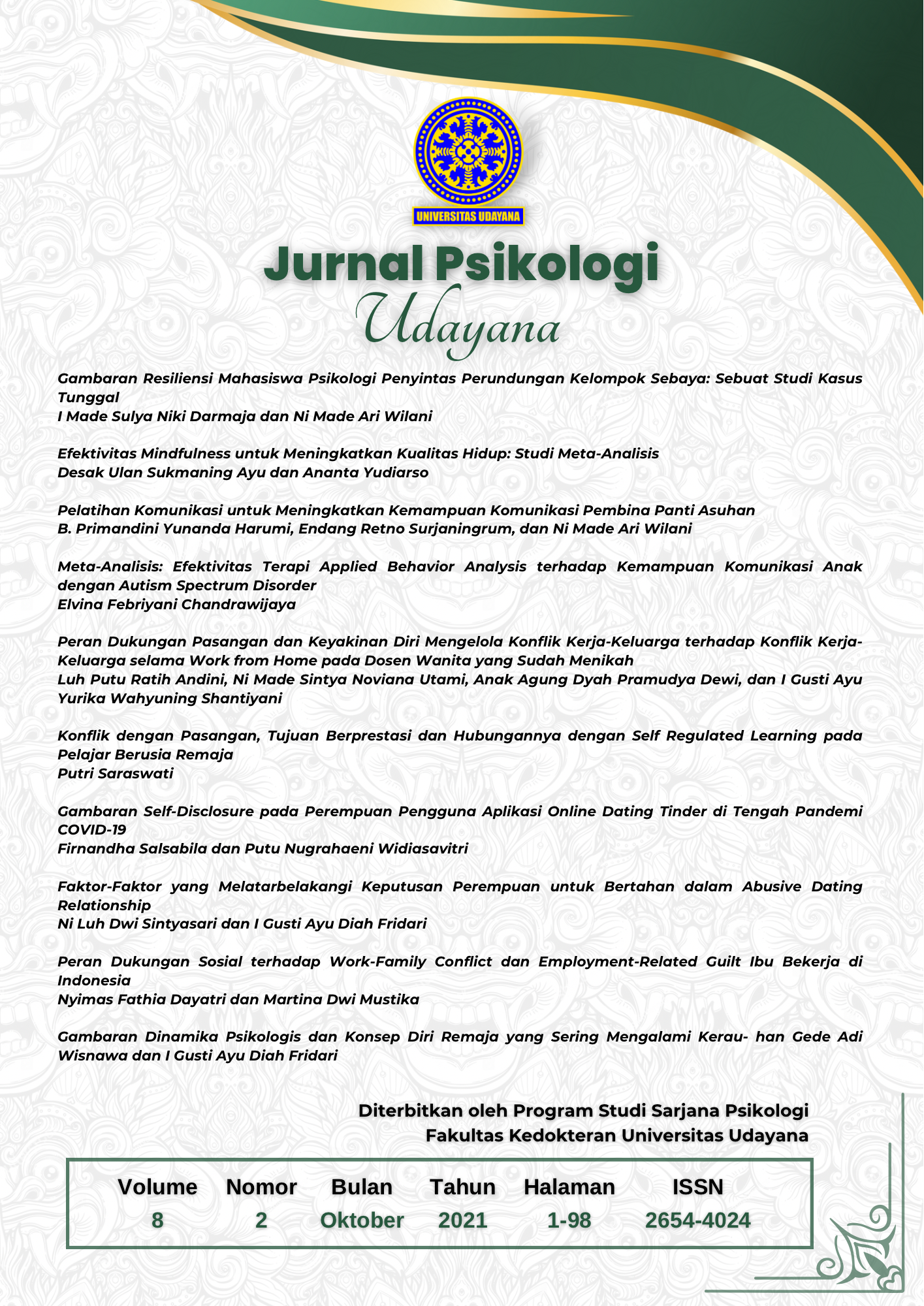Meta analisis: Efektivitas terapi Applied Behavior Analysis terhadap kemampuan komunikasi anak dengan Autism Spectrum Disorder
Abstract
Many children with Autism Spectrum Disorder (ASD) become frustrated in their attempts to make their feelings, thoughts, and needs known. They may act out their frustrations through inappropriate behaviors. This lack of communication skill needs to be treated early to prevent future developmental delays. Applied Behavior Analysis (ABA) is the most frequently used intervention for children with Autism Spectrum Disorder (ASD). However, many studies have found inconsistent results regarding its effectiveness. This study aims to determine the effectiveness of ABA on the communication skills of children with ASD assessed by Vineland Adaptive Behavior Scales (VABS). Meta analysis method is used in this study. Data is processed through statdirect trial version 3.0 application. This study involved 14 experiments using ABA therapy for children with ASD (total n experiment groups = 304 and total n control groups = 244). Based M, SD, and N on data analysis, the effect size value obtained from the fixed effect (I² = 55.7%) was 0.210 (95% CI = 0.035 to 0.384; small effect size). These results do not support the effectiveness of ABA in improving communication skills in ASD children. We suggests that ABA therapy should be carried out with other interventions that target specific communication skills. Future researchers should conduct research replication to increase references on the effectiveness of ABA therapy.
Downloads
References
American Psychiatric Association (APA). (2013). Diagnostic and statistical manual of mental disorders (5th ed., pp. 5–25). Arlington, VA: American Psychiatric Publishing.
Baer, D. M., Wolf, M. M., & Risley, T. R. (1987). Some still‐current dimensions of applied behavior analysis. Journal of Applied Behavior Analysis, 20(4), 313-327.
Cohen, H., Amerine-Dickens, M., & Smith, T. (2006). Early intensive behavioral treatment: Replication of the UCLA model in a community setting. Journal of Developmental & Behavioral Pediatrics, 27, 145–155.
Daar, J. H., Negrelli, S., & Dixon, M. R. (2015). Derived emergence of WH question–answers in children with autism. Research in Autism Spectrum Disorders, 19, 59-71
Drew, C. J. (2010). Vineland Adaptive Behavior Scales. The Corsini Encyclopedia of Psychology, 1-1.
Egger, M., Smith, G. D., Schneider, M., & Minder, C. (1997). Bias in meta-analysis detected by a simple, graphical test. British Medical Journal, 315, 629-634. https://doi.org/10.1136/bmj.315.7109.629
Eikeseth, S., Klintwall, L., Jahr, E., & Karlsson, P. (2012). Outcome for children with autism receiving early and intensive behavioral intervention in mainstream preschool and kindergarten settings. Research in Autism Spectrum Disorders, 6, 829–835.
Eikeseth, S., Smith, T., Jahr, E., & Eldevik, S. (2002). Intensive behavioral treatment at school for 4- to 7-year-old children with autism: A 1-year comparison controlled study. Behavior Modification, 26, 49–68.
Eldevik, S., Eikeseth, S., Jahr, E., & Smith, T. (2006). Effects of low-intensity behavioral treatment for children with autism and mental retardation. Journal of Autism and Developmental Disorders, 36, 211–224.
Eldevik, S., Hastings, R. P., Jahr, E., & Hughes, J. C. (2012). Outcomes of behavioral intervention for children with autism in mainstream pre-school settings. Journal of Autism and Developmental Disorders, 42, 210–220.
Elsayir, H. A. (2012). Computation and interpretation of effect size in significance test. International Refereed Journal of Engineering and SCience, 1(4), 27–32.
Grindle, C. F., Hastings, R. P., Saville, M., Hughes, J. C., Huxley, K., Kovshoff, H., ... Remington, B. (2012). Outcomes of a behavioral education model for children with autism in a mainstream school setting. Behavior Modification, 36, 298–319.
Hayward, D., Eikeseth, S., Gale, C., & Morgan, S. (2009). Assessing progress during treatment for young children with autism receiving intensive behavioural interventions. Autism, 13, 613–633.
Hess, K. L., Morrier, M. J., Heflin, L. J., & Ivey, M. L. (2008). Autism treatment survey: Services received by children with autism spectrum disorders in public school classrooms. Journal of autism and developmental disorders, 38(5), 961-971.
Howard, J. S., Sparkman, C. R., Cohen, H. G., Green, G., & Stanislaw, H. (2005). A comparison of intensive behavior analytic and eclectic treatment for young children with autism. Research in Developmental Disabilities, 26, 359–383.
Magiati, I., Charman, T., & Howlin, P. (2007). A two-year prospective follow-up study of community-based early intensive behavioural intervention and specialist nursery provision for children with autism spectrum disorders. Journal of Child Psychology and Psychiatry, 48, 803–812.
Makrygianni, M. K., Gena, A., Katoudi, S., & Galanis, P. (2018). The effectiveness of applied behavior analytic interventions for children with Autism Spectrum Disorder: A meta-analytic study. Research in Autism Spectrum Disorders, 51, 18-31.
Pearson, D. A., Loveland, K. A., Lachar, D., Lane, D. M., Reddoch, S. L., Mansour, R., & Cleveland, L. A. (2006). A comparison of behavioral and emotional functioning in children and adolescents with autistic disorder and PDD-NOS. Child Neuropsychology, 12(4-5), 321-333.
Peters-Scheffer, N., Didden, R., Korzilius, H., & Sturmey, P. (2011). A meta-analytic study on the effectiveness of comprehensive ABA-based early intervention programs for children with autism spectrum disorders. Research in Autism Spectrum Disorders, 5(1), 60-69.
Reed, P., Osborne, L. A., & Corness, M. (2007). The real-world effectiveness of early teaching interventions for children with Autism Spectrum Disorder. Exceptional Children, 73, 417–433.
Reichow, B., Barton, E. E., Boyd, B. A., & Hume, K. (2012). Early intensive behavioral intervention (EIBI) for young children with autism spectrum disorders (ASD). Cochrane Database of Systematic Reviews, (10).
Remington, B., Hastings, R. P., Kovshoff, H., Degli Espinosa, F., Jahr, W., Brown, T., et al. (2007). A field effectiveness study of early intensive behavioral intervention: Outcomes for children with autism and their parents after two years. American Journal of Mental Retardation, 112, 418–438.
Sallows, G. O., & Graupner, T. D. (2005). Intensive behavioral treatment for children with Autism: Four-year outcome and predictors. American Journal on Mental Retardation, 110, 417–438.
Shelby, L. B., & Vaske, J. J. (2008). Understanding meta-analysis : A review of the methodological. Leisure Science, 30, 96–110. https://doi.org/10.1080/01490400701881366
Smith, R., Groen, A. D., & Wynn, J. W. (2000). Randomized trial of intensive early intervention for children with pervasive developmental disorder. American Journal on Mental Retardation, 105, 269–285.
Wodka, E. L., Mathy, P., & Kalb, L. (2013). Predictors of phrase and fluent speech in children with autism and severe language delay. Pediatrics, 131(4), 1128–1134.
Zachor, D. A., & Ben-Itzchak, E. (2010). Treatment approach, autism severity and intervention outcomes in young children. Research in Autism Spectrum Disorders, 4(3), 425–432.

This work is licensed under a Creative Commons Attribution-ShareAlike 4.0 International License.
Authors who publish with this journal agree to the following terms:
- Authors retain copyright and grant the journal right of first publication with the work simultaneously licensed under a Creative Commons Attribution-ShareAlike 4.0 International License that allows others to share the work with an acknowledgement of the works authorship and initial publication in this journal.
- Authors are able to enter into separate, additional contractual arrangements for the non-exclusive distribution of the journals published version of the work (e.g., post it to an institutional repository or publish it in a book), with an acknowledgement of its initial publication in this journal.
- Authors are permitted and encouraged to post their work online (e.g., in institutional repositories or on their website) prior to and during the submission process, as it can lead to productive exchanges, as well as earlier and greater citation of published work (See The Effect of Open Access).













